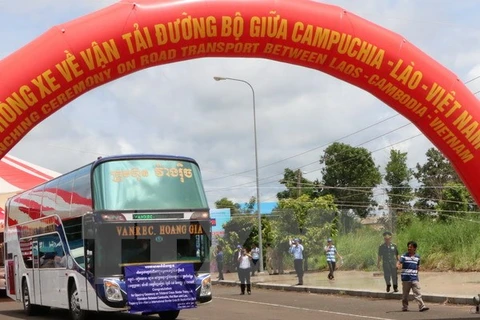Hanoi (VNA) - Current shortcomings in road transport across the border between Vietnam and other countries in the region need to be solved to enhance connectivity to the international road transport system, experts said.
Deputy General Director of the Vietnam Road Administration Phan Thi Thu Hien recently stated that Vietnam has many geographic advantages to participate in transnational transport, but current difficulties have created many barriers to international transport connections and socio-economic development.
Although Vietnam and other regional countries such as Laos, Cambodia, Thailand have made agreements to facilitate road transport, border linkage has not been fully implemented due to differences in legislation systems, Hien said.
According to traffic experts, road transport agreements have facilitated trade and tourism development and cost reduction, increased competitiveness and contributed to the socio-economic development.
Many border agreements have been adopted. But number of vehicles traveling through border gates among countries in the region is still limited, Hien said.
Nguyen Tuong, Deputy General Secretary of Vietnam Logistics Association said although many transport agreements were signed among countries but regulations of the countries has not yet unified so it was making difficulties to multilateral transport operation.
Such problem includes left or right driving, insurance liability for motorised vehicles, lack of storage or delayed procedures, Tuong said.
In addition, incomplete traffic systems at main border gates between Vietnam and Laos and Cambodia has reduced the efficiency of cross-border road transportation, experts said.
Many border gates could not meet demand of transportation in peak hours, Tuong said.
He suggested that Vietnam needs to quickly build a strategy and policies for the development of cross-border transport, especially transport corridors.
This will be particularly significant when the country integrates into the ASEAN Economic Community, he said.
There should be more policies developing cross-border transport of goods in transit in order to attract goods from Cambodia and Laos, especially goods transported by containers.
According to head of Ministry of Transport’s Road Safety Department Nguyen Van Thach, the current bilateral agreements on road transport between Vietnam and other countries in the region have progressed very slowly.
At present, only few Vietnamese transport businesses have licensed freight international roads in the territory of the countries of Vietnam, Laos, Cambodia, Thailand, Myanmar and some provinces of China, Thach said.
To facilitate the transport, ASEAN countries need to formulate regulations and simplify the administrative procedures in order to speed up the implementation of one-stop-shop customs models so as to halve the time of customs clearance procedures, promote connections and trading among countries in the region, he added.
As an example, he showed how the customs clearance time between Vietnam and Laos at border gate reduced sharply since applying this model.
It costs only 15 minutes for truck to do customs declaration at Lao Bao-Densavan international border gate between Vietnam and Laos, he said.
"Vietnam has the advantage of being located on the transit of international routes, so the cross-border transport plays a special role. Therefore, relevant agencies need to join hands to strengthen enforcement of the signed agreements on cross-border transport development," said Thach.-VNA
Vietnam, Thailand boost road transport cooperation
The Transport Development and Strategy Institute in conjunction with the Thai Department of Land Transportation held a workshop in Ho Chi Minh City on December 13, aiming to improve the capacity of enterprises transporting goods.





















